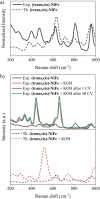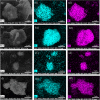Harnessing the electronic structure of active metals to lower the overpotential of the electrocatalytic oxygen evolution reaction
- PMID: 38274069
- PMCID: PMC10806668
- DOI: 10.1039/d3sc05891c
Harnessing the electronic structure of active metals to lower the overpotential of the electrocatalytic oxygen evolution reaction
Abstract
Despite substantial advancements in the field of the electrocatalytic oxygen evolution reaction (OER), the efficiency of earth-abundant electrocatalysts remains far from ideal. The difficulty stems from the complex nature of the catalytic system, which limits our fundamental understanding of the process and thus the possibility of a rational improvement of performance. Herein, we shed light on the role played by the tunable 3d configuration of the metal centers in determining the OER catalytic activity by combining electrochemical and spectroscopic measurements with an experimentally validated computational protocol. One-dimensional coordination polymers based on Fe, Co and Ni held together by an oxonato linker were selected as a case study because of their well-defined electronic and geometric structure in the active site, which can be straightforwardly correlated with their catalytic activity. Novel heterobimetallic coordination polymers were also considered, in order to shed light on the cooperativity effects of different metals. Our results demonstrate the fundamental importance of electronic structure effects such as metal spin and oxidation state evolutions along the reaction profile to modulate ligand binding energies and increase catalyst efficiency. We demonstrated that these effects could in principle be exploited to reduce the overpotential of the electrocatalytic OER below its theoretical limit, and we provide basic principles for the development of coordination polymers with a tailored electronic structure and activity.
This journal is © The Royal Society of Chemistry.
Conflict of interest statement
There are no conflicts to declare.
Figures








References
-
- Ursua A. Gandia L. M. Sanchis P. Hydrogen Production from Water Electrolysis: Current Status and Future Trends. Proc. IEEE. 2012;100(2):410–426. doi: 10.1109/JPROC.2011.2156750. - DOI
-
- Chatenet M. Pollet B. G. Dekel D. R. Dionigi F. Deseure J. Millet P. Braatz R. D. Bazant M. Z. Eikerling M. Staffell I. Balcombe P. Shao-Horn Y. Schäfer H. Water Electrolysis: From Textbook Knowledge to the Latest Scientific Strategies and Industrial Developments. Chem. Soc. Rev. 2022;51(11):4583–4762. doi: 10.1039/D0CS01079K. doi: 10.1039/D0CS01079K. - DOI - DOI - PMC - PubMed
LinkOut - more resources
Full Text Sources

